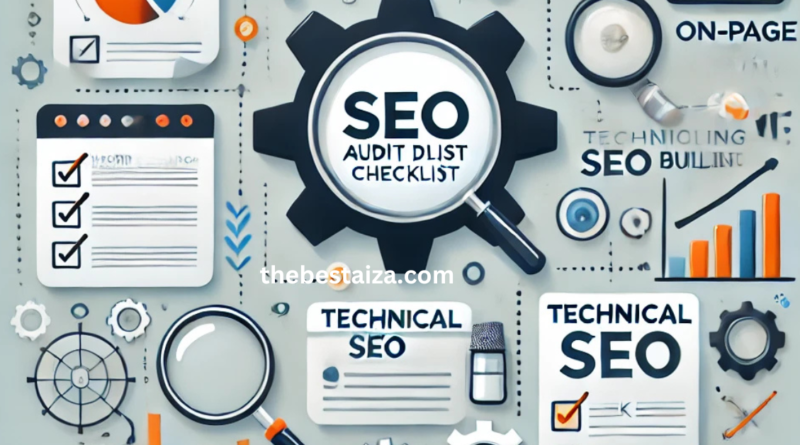SEO Audit
SEO Audit Checklist for Beginners
SEO (Search Engine Optimization) is vital to improving your website’s visibility in search engines. A comprehensive SEO audit is the first step toward identifying areas for improvement and optimization. For beginners, the task may seem overwhelming, but by following a structured approach, you can easily perform an SEO audit and start enhancing your website’s performance. thebestaiza
This guide will walk you through an SEO audit checklist for beginners and explain the crucial elements you need to consider.
Why is an SEO Audit Important?
An SEO audit evaluates how well your website is optimized for search engines and uncovers technical issues, content gaps, and opportunities for keyword improvement. Regular SEO audits help you:
- Improve your site’s organic traffic.
- Identify technical issues that hinder rankings.
- Align your website with current SEO best practices.
Beginner’s SEO Audit Checklist
Let’s break down the essential components of an SEO audit into manageable tasks:
1. Keyword Research and Optimization
A crucial part of SEO is understanding the keywords your target audience is using. You must ensure that your website’s content is optimized for relevant, high-impact keywords. To get started:
- Review your keyword list: Ensure that your primary and secondary keywords match user intent and are relevant to your niche.
- Analyze keyword usage: Use tools like Google Search Console to see which keywords are driving traffic. In the world of SEO, using the right keywords is crucial to driving traffic to your website.
- Look for long-tail keywords: These lower-competition keywords often have higher conversion rates.
2. On-Page SEO Elements
On-page SEO refers to the factors you can control directly within your website. This is a foundational step in your SEO audit. Key areas to evaluate:
- Title Tags: Make sure each page has a unique, keyword-rich title tag.
- Meta Descriptions: Optimize meta descriptions by including keywords and crafting them to encourage clicks.
- Header Tags: Use H1, H2, and H3 tags properly to structure your content. The primary heading (H1) should be descriptive and include your target keyword.
- Image Optimization: Check that all images have proper alt text describing the image content and, when possible, include relevant keywords.
- Here’s a **unique version** of the line you requested:
URL Formatting: Make sure your URLs are concise, meaningful, and optimized for SEO purposes.
3. Technical SEO Audit
The technical aspects of SEO ensure that search engines can effectively crawl and index your site. For beginners, here are the most crucial technical checks:
- Mobile-Friendliness: Use Google’s Mobile-Friendly Test tool to ensure your site is responsive and displays correctly on mobile devices.
- Site Speed: Slow load times can hurt your SEO. Use tools like Google PageSpeed Insights to check and improve page speed.
- SSL Certificate: Ensure your website uses HTTPS to signal to search engines that your site is secure.
- Indexability: Check your site’s robots.txt file to ensure important pages are not being blocked from indexing.
- Sitemap: Submit an XML sitemap to search engines for efficient indexing of your pages.
4. Backlink Profile
Backlinks are an essential part of off-page SEO and can significantly impact your site’s authority and ranking. Here’s how to audit your backlink profile:
- Analyze Backlinks: Use tools like Ahrefs or Moz to review your site’s backlink profile.Here’s a unique version of the line: Prioritize building backlinks from reputable and authoritative websites to enhance your site’s credibility and ranking.
- Disavow Toxic Links: If you find harmful or spammy links pointing to your site, disavow them using Google’s Disavow Tool.
- Look for Opportunities: Identify high-quality websites in your niche for guest blogging or outreach to gain backlinks.
5. Content Quality and Relevance
Here’s a unique version of that line: Search engines give precedence to well-crafted content that aligns with and fulfills user intent.
. A content audit will help you evaluate the quality and relevance of your website’s existing content.
- Update Old Content: Refresh outdated articles and blog posts by adding new information, updating statistics, and including new keywords.
- Thin Content: Identify pages with thin content (little to no useful information) and either remove or improve them.
- Content Duplication: Use tools like Copyscape or SiteLiner to check for duplicate content on your site, as this can negatively impact SEO.
6. User Experience (UX)
Good user experience keeps visitors engaged on your site, which indirectly boosts SEO performance. Consider the following:
- Navigation: Ensure your website is easy to navigate, with a clear structure and working links.
- Mobile Navigation: Your mobile menu should be intuitive and easily accessible.
- CTAs (Call to Actions): Optimize CTAs to guide users towards conversions or desired actions on the page.
Conclusion
Conducting an SEO audit doesn’t have to be intimidating, even for beginners. By following this SEO audit checklist for beginners, you can systematically assess your website’s strengths and weaknesses. Regular audits will help you stay on top of your SEO game, ensuring your site stays visible and competitive in search engine rankings.

